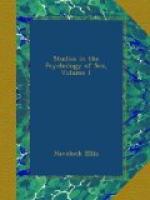There is only one further point to which attention may be called. I allude to the way in which the more favorable side of the primitive conception of the menstruating woman—as priestess, sibyl, prophetess, an almost miraculous agent for good, an angel, the peculiar home of the divine element—was slowly and continuously carried on side by side with the less favorable view, through the beginnings of European civilization until our own times. The actual physical phenomena of menstruation, with the ideas of taboo associated with that state, sank into the background as culture evolved; but, on the other hand, the ideas of the angelic position and spiritual mission of women, based on the primitive conception of the mystery associated with menstruation, still in some degree persisted.
It is evident, however, that, while, in one form or another, the more favorable aspect of the primitive view of women’s magic function has never quite died out, the gradual decay and degradation of the primitive view has, on the whole, involved a lower estimate of women’s nature and position. Woman has always been the witch; she was so even in ancient Babylonia; but she has ceased to be the priestess. The early Teutons saw “sanctum aliquid et providum” in women who, for the mediaeval German preacher, were only “bestiae bipedales”; and Schopenhauer and even Nietzsche have been more inclined to side with the preacher than with the half-naked philosophers of Tacitus’s day. But both views alike are but the extremes of the same primitive conception; and the gradual evolution from one extreme of the magical doctrine to the other was inevitable.
In an advanced civilization, as we see, these ideas having their ultimate basis on the old story of the serpent, and on a special and mysterious connection between the menstruating woman and the occult forces of magic, tend to die out. The separation of the sexes they involve becomes unnecessary. Living in greater community with men, women are seen to possess something, it may well be, but less than before, of the angel-devil of early theories. Menstruation is no longer a monstrific state requiring spiritual taboo, but a normal physiological process, not without its psychic influences on the woman herself and on those who live with her.
FOOTNOTES:
[353] Several recent works, however, notably Frazer’s Golden Bough and Crawley’s Mystic Rose, throw light directly or indirectly on this question.
[354] Robertson Smith points out that since snakes are the last noxious animals which man is able to exterminate, they are the last to be associated with demons. They were ultimately the only animals directly and constantly associated with the Arabian jinn, or demon, and the serpent of Eden was a demon, and not a temporary disguise of Satan (Religion of Semites, pp. 129 and 442). Perhaps it was, in part, because the snake was thus the last embodiment of demonic power that women were associated with it, women being always connected with the most ancient religious beliefs.




